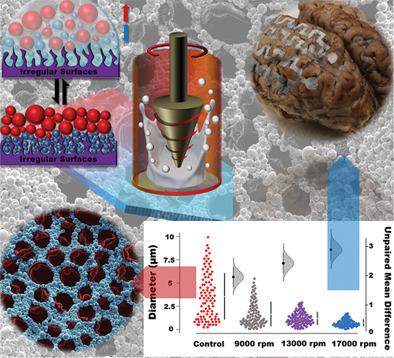当前位置:
X-MOL 学术
›
Adv. Mater. Interfaces
›
论文详情
Our official English website, www.x-mol.net, welcomes your
feedback! (Note: you will need to create a separate account there.)
Polydispersity‐Driven Printing of Conformal Solid Metal Traces on Non‐Adhering Biological Surfaces
Advanced Materials Interfaces ( IF 4.3 ) Pub Date : 2020-09-09 , DOI: 10.1002/admi.202001294 Andrew Martin 1 , Chuanshen Du 1 , Alana M. Pauls 1 , Thomas Ward 2 , Martin Thuo 1, 3, 4
Advanced Materials Interfaces ( IF 4.3 ) Pub Date : 2020-09-09 , DOI: 10.1002/admi.202001294 Andrew Martin 1 , Chuanshen Du 1 , Alana M. Pauls 1 , Thomas Ward 2 , Martin Thuo 1, 3, 4
Affiliation

|
Metals and organics possess two very dissimilar surface energies, hence, do not naturally adhere to each other. This incompatibility is exacerbated by surface roughness yet advances in wearables and bioelectronics call for their integration. Mesoscale mechanical bonds, however, transcend the necessities of surface energy matching while taking advantage of surface texture. Herein, transient carrier fluids, particle size polydispersity, and capillary‐driven autonomous size‐sorting are exploited to conformally jam undercooled liquid metal particles on textured soft substrate. The well packed undercooled metal particles are then chemically activated to induce phase change, leading to a solid electrically conductive metal trace. Static and dynamic deposition of the particles is amenable to this surface‐templated printing of conductive traces. This process allows for printing across surfaces with varying surface features like on the brain, on paper (asymmetric porosity), or across smooth and rough brain sections. By tuning particle size and slurry concentration, good particle packing is demonstrated on a multi‐scale rough surface like a rose flower. This printing method is therefore compatible with delicate (low modulus), heat sensitive, and textured substrates hence compatible with biological tissues and organic substrates.
中文翻译:

在非粘附生物表面上保形固体金属痕迹的多分散性驱动印刷
金属和有机物具有两种非常不同的表面能,因此不会自然地相互粘附。表面粗糙度加剧了这种不相容性,但可穿戴设备和生物电子学的进步要求它们的整合。然而,中尺度机械键超越了表面能匹配的必要性,同时利用了表面纹理。在此,利用瞬态载流流体,粒度多分散性和毛细管驱动的自主尺寸分类技术,将过冷的液态金属颗粒保形地卡在带纹理的软质基材上。然后将填充充分的过冷金属颗粒化学活化,以引起相变,从而产生固体导电金属痕迹。可以通过此表面模板印刷导电迹线来实现粒子的静态和动态沉积。此过程允许在具有变化的表面特征的表面上进行打印,例如在大脑,纸张(不对称孔隙率)上或在平滑和粗糙的大脑区域上进行打印。通过调节颗粒大小和浆液浓度,可以在玫瑰花等多尺度粗糙表面上证明良好的颗粒堆积。因此,该印刷方法与易碎的(低模量),热敏和纹理化的基材兼容,因此与生物组织和有机基材兼容。
更新日期:2020-09-09
中文翻译:

在非粘附生物表面上保形固体金属痕迹的多分散性驱动印刷
金属和有机物具有两种非常不同的表面能,因此不会自然地相互粘附。表面粗糙度加剧了这种不相容性,但可穿戴设备和生物电子学的进步要求它们的整合。然而,中尺度机械键超越了表面能匹配的必要性,同时利用了表面纹理。在此,利用瞬态载流流体,粒度多分散性和毛细管驱动的自主尺寸分类技术,将过冷的液态金属颗粒保形地卡在带纹理的软质基材上。然后将填充充分的过冷金属颗粒化学活化,以引起相变,从而产生固体导电金属痕迹。可以通过此表面模板印刷导电迹线来实现粒子的静态和动态沉积。此过程允许在具有变化的表面特征的表面上进行打印,例如在大脑,纸张(不对称孔隙率)上或在平滑和粗糙的大脑区域上进行打印。通过调节颗粒大小和浆液浓度,可以在玫瑰花等多尺度粗糙表面上证明良好的颗粒堆积。因此,该印刷方法与易碎的(低模量),热敏和纹理化的基材兼容,因此与生物组织和有机基材兼容。











































 京公网安备 11010802027423号
京公网安备 11010802027423号